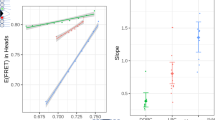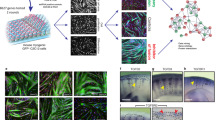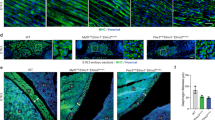Abstract
The fusion of mononucleated myoblasts produces multinucleated muscle fibers leading to the formation of skeletal muscle. Myomaker, a skeletal muscle-specific membrane protein, is essential for myoblast fusion. Here we report the cryo-EM structures of mouse Myomaker (mMymk) and Ciona robusta Myomaker (cMymk). Myomaker contains seven transmembrane helices (TMs) that adopt a G-protein-coupled receptor-like fold. TMs 2–4 form a dimeric interface, while TMs 3 and 5–7 create a lipid-binding site that holds the polar head of a phospholipid and allows the alkyl tails to insert into Myomaker. The similarity of cMymk and mMymk suggests a conserved Myomaker-mediated cell fusion mechanism across evolutionarily distant species. Functional analyses demonstrate the essentiality of the dimeric interface and the lipid-binding site for fusogenic activity, and heterologous cell–cell fusion assays show the importance of transcellular interactions of Myomaker protomers for myoblast fusion. Together, our findings provide structural and functional insights into the process of myoblast fusion.
This is a preview of subscription content, access via your institution
Access options
Access Nature and 54 other Nature Portfolio journals
Get Nature+, our best-value online-access subscription
$29.99 / 30 days
cancel any time
Subscribe to this journal
Receive 12 print issues and online access
$189.00 per year
only $15.75 per issue
Buy this article
- Purchase on Springer Link
- Instant access to full article PDF
Prices may be subject to local taxes which are calculated during checkout




Similar content being viewed by others
Data availability
Sequences of the anti-Myomaker antibody candidates were analyzed with the IMGT database (http://www.imgt.org/). The 3D cryo-EM density maps have been deposited in the Electron Microscopy Data Bank under the accession numbers EMD-40933 (mMymk in detergent), EMD-40934 (mMymk in nanodiscs), EMD-40935 (cMymk), EMD-40936 (mMymkR107A) and EMD-40937 (mMymkY118A). Atomic coordinates for the atomic model have been deposited in the Protein Data Bank (PDB) under the accession numbers 8T03 (mMymk in detergent), 8T04 (mMymk in nanodiscs), 8T05 (cMymk), 8T06 (mMymkR107A) and 8T07 (mMymkY118A). Additional data supporting the findings in this study are provided as source data and supplementary information to this paper.
References
Kim, J. H., Jin, P., Duan, R. & Chen, E. H. Mechanisms of myoblast fusion during muscle development. Curr. Opin. Genet Dev. 32, 162–170 (2015).
Buckingham, M. Myogenic progenitor cells and skeletal myogenesis in vertebrates. Curr. Opin. Genet Dev. 16, 525–532 (2006).
Kim, J. H. & Chen, E. H. The fusogenic synapse at a glance. J. Cell Sci. https://doi.org/10.1242/jcs.213124 (2019).
Demonbreun, A. R., Biersmith, B. H. & McNally, E. M. Membrane fusion in muscle development and repair. Semin. Cell Dev. Biol. 45, 48–56 (2015).
Hindi, S. M., Tajrishi, M. M. & Kumar, A. Signaling mechanisms in mammalian myoblast fusion. Sci. Signal 6, re2 (2013).
Leikina, E. et al. Myomaker and Myomerger work independently to control distinct steps of membrane remodeling during myoblast fusion. Dev. Cell 46, 767–780.e767 (2018).
Millay, D. P. et al. Myomaker is a membrane activator of myoblast fusion and muscle formation. Nature 499, 301–305 (2013).
Millay, D. P., Sutherland, L. B., Bassel-Duby, R. & Olson, E. N. Myomaker is essential for muscle regeneration. Genes Dev. 28, 1641–1646 (2014).
Di Gioia, S. A. et al. A defect in myoblast fusion underlies Carey-Fineman-Ziter syndrome. Nat. Commun. 8, 16077 (2017).
Hedberg-Oldfors, C., Lindberg, C. & Oldfors, A. Carey-Fineman-Ziter syndrome with mutations in the myomaker gene and muscle fiber hypertrophy. Neurol. Genet. 4, e254 (2018).
Jumper, J. et al. Highly accurate protein structure prediction with AlphaFold. Nature 596, 583–589 (2021).
Millay, D. P. et al. Structure-function analysis of myomaker domains required for myoblast fusion. Proc. Natl Acad. Sci. Acad. 113, 2116–2121 (2016).
Lee, G. H. et al. A GPI processing phospholipase A2, PGAP6, modulates Nodal signaling in embryos by shedding CRIPTO. J. Cell Biol. 215, 705–718 (2016).
Zhang, H. et al. Evolution of a chordate-specific mechanism for myoblast fusion. Sci. Adv. 8, eadd2696 (2022).
Du, J. et al. Structures of human mGlu2 and mGlu7 homo- and heterodimers. Nature 594, 589–593 (2021).
Velazhahan, V. et al. Structure of the class D GPCR Ste2 dimer coupled to two G proteins. Nature 589, 148–153 (2021).
Soderberg, O. et al. Characterizing proteins and their interactions in cells and tissues using the in situ proximity ligation assay. Methods 45, 227–232 (2008).
Holm, L. & Rosenstrom, P. Dali server: conservation mapping in 3D. Nucleic Acids Res. 38, W545–W549 (2010).
Vasiliauskaite-Brooks, I. et al. Structure of a human intramembrane ceramidase explains enzymatic dysfunction found in leukodystrophy. Nat. Commun. 9, 5437 (2018).
Tanabe, H. et al. Human adiponectin receptor AdipoR1 assumes closed and open structures. Commun. Biol. 3, 446 (2020).
Waltenspuhl, Y., Schoppe, J., Ehrenmann, J., Kummer, L. & Pluckthun, A. Crystal structure of the human oxytocin receptor. Sci. Adv. 6, eabb5419 (2020).
Perez-Vargas, J. et al. Structural basis of eukaryotic cell-cell fusion. Cell 157, 407–419 (2014).
Zhang, J. et al. Species-specific gamete recognition initiates fusion-driving trimer formation by conserved fusogen HAP2. Nat. Commun. 12, 4380 (2021).
Jeong, J. & Conboy, I. M. Phosphatidylserine directly and positively regulates fusion of myoblasts into myotubes. Biochem. Biophys. Res. Commun. 414, 9–13 (2011).
Tsuchiya, M. et al. Cell surface flip-flop of phosphatidylserine is critical for PIEZO1-mediated myotube formation. Nat. Commun. 9, 2049 (2018).
Bi, P. et al. Control of muscle formation by the fusogenic micropeptide myomixer. Science 356, 323–327 (2017).
Lee, D. M. & Chen, E. H. Drosophila myoblast fusion: invasion and resistance for the ultimate union. Annu. Rev. Genet. 53, 67–91 (2019).
Srinivas, B. P., Woo, J., Leong, W. Y. & Roy, S. A conserved molecular pathway mediates myoblast fusion in insects and vertebrates. Nat. Genet. 39, 781–786 (2007).
Long, T., Liu, Y. & Li, X. Molecular structures of human ACAT2 disclose mechanism for selective inhibition. Structure https://doi.org/10.1016/j.str.2021.07.009 (2021).
Sun, Y. & Li, X. Cholesterol efflux mechanism revealed by structural analysis of human ABCA1 conformational states. Nat. Cardiovasc. Res. 1, 238–245 (2022).
Ritchie, T. K. et al. Chapter 11—reconstitution of membrane proteins in phospholipid bilayer nanodiscs. Methods Enzymol. 464, 211–231 (2009).
Liu, Y. et al. Mechanisms and inhibition of Porcupine-mediated Wnt acylation. Nature 607, 816–822 (2022).
Guo, X. et al. Structure and mechanism of human cystine exporter cystinosin. Cell 185, 3739–3752 (2022).
Wang, Q. et al. A combination of human broadly neutralizing antibodies against hepatitis B virus HBsAg with distinct epitopes suppresses escape mutations. Cell Host Microbe 28, 335–349.e336 (2020).
Rasmussen, S. G. et al. Crystal structure of the human beta2 adrenergic G-protein-coupled receptor. Nature 450, 383–387 (2007).
Mastronarde, D. N. Automated electron microscope tomography using robust prediction of specimen movements. J. Struct. Biol. 152, 36–51 (2005).
Li, X. et al. Electron counting and beam-induced motion correction enable near-atomic-resolution single-particle cryo-EM. Nat. Methods 10, 584–590 (2013).
Zivanov, J. et al. New tools for automated high-resolution cryo-EM structure determination in RELION-3. eLife https://doi.org/10.7554/eLife.42166 (2018).
Rohou, A. & Grigorieff, N. CTFFIND4: fast and accurate defocus estimation from electron micrographs. J. Struct. Biol. 192, 216–221 (2015).
Wagner, T. et al. SPHIRE-crYOLO is a fast and accurate fully automated particle picker for cryo-EM. Commun. Biol. 2, 218 (2019).
Punjani, A., Rubinstein, J. L., Fleet, D. J. & Brubaker, M. A. cryoSPARC: algorithms for rapid unsupervised cryo-EM structure determination. Nat. Methods 14, 290–296 (2017).
Emsley, P. & Cowtan, K. Coot: model-building tools for molecular graphics. Acta Crystallogr. D 60, 2126–2132 (2004).
Adams, P. D. et al. PHENIX: a comprehensive Python-based system for macromolecular structure solution. Acta Crystallogr. D 66, 213–221 (2010).
Murshudov, G. N., Vagin, A. A. & Dodson, E. J. Refinement of macromolecular structures by the maximum-likelihood method. Acta Crystallogr. D 53, 240–255 (1997).
Croll, T. I. ISOLDE: a physically realistic environment for model building into low-resolution electron-density maps. Acta Crystallogr. D. Struct. Biol. 74, 519–530 (2018).
Chen, V. B. et al. MolProbity: all-atom structure validation for macromolecular crystallography. Acta Crystallogr. D 66, 12–21 (2010).
Pettersen, E. F. et al. UCSF ChimeraX: structure visualization for researchers, educators, and developers. Protein Sci. 30, 70–82 (2021).
Song, K. et al. Heart repair by reprogramming non-myocytes with cardiac transcription factors. Nature 485, 599–604 (2012).
Ramirez-Martinez, A. et al. Impaired activity of the fusogenic micropeptide Myomixer causes myopathy resembling Carey-Fineman-Ziter syndrome. J. Clin. Invest. https://doi.org/10.1172/JCI159002 (2022).
Acknowledgements
The cryo-EM data were collected at the UT Southwestern Medical Center Cryo-EM Facility (funded in part by the Cancer Prevention and Research Institute of Texas (CPRIT) Core Facility Support Award no. RP170644). We thank R. Bassel-Duby for guidance and assistance in many aspects of this work, L. Beatty and Y. Qin for cell culture and P. Bi for providing the cDNA of cMymk and helpful discussion. This work was supported by grant nos. AHA 23EIA1038669 (X.L.), NIH P01 HL160487 (X.L.), R01 GM135343 (X.L.) and R01 AR067294 (E.N.O.), the Robert A. Welch Foundation (grant nos. I-0025 to E.N.O. and I-1957 to X.L.) and the CPRIT (grant no. RP200103 to E.N.O.).
Author information
Authors and Affiliations
Contributions
T.L., Y.Z., E.N.O. and X.L. designed the research. T.L. performed the biochemical and structural experiments. T.L. and L.D. screened the monoclonal antibodies. Y.Z., Y.-C.P. and H.L. performed functional analysis. T.L., Y.Z., N.L., E.N.O. and X.L. analyzed the data and contributed to paper preparation. T.L., Y.Z., E.N.O. and X.L. wrote the paper. E.N.O. and X.L. supervised the project.
Corresponding authors
Ethics declarations
Competing interests
The authors declare no competing interests.
Peer review
Peer review information
Nature Structural & Molecular Biology thanks Stephen Muench, Pier Lorenzo Puri and the other, anonymous, reviewer(s) for their contribution to the peer review of this work. Peer reviewer reports are available. Primary Handling Editor: Katarzyna Ciazynska, in collaboration with the Nature Structural & Molecular Biology team.
Additional information
Publisher’s note Springer Nature remains neutral with regard to jurisdictional claims in published maps and institutional affiliations.
Extended data
Extended Data Fig. 1 Representative gel-filtration chromatograms of Myomaker complex with Fab.
a, Fab18G7-bound mMymkWT in lipid nanodiscs. b, Fab18G7-bound mMymkWT in detergent. c, Fab18G7-bound mMymkR107A in detergent. d, Fab18G7-bound mMymkY118A in detergent. e, Fab1A1-bound cMymkWT in detergent. The fraction of each complex is shown on SDS–PAGE with molecular markers and proteins indicated. The peak of each excess fab is indicated. Data shown are representative of two independent experiments.
Extended Data Fig. 2 Cryo-EM analyses of mMymk.
a and b, Summary of image processing procedures of mMymk in nanodiscs (a) and detergent (b). The cryo-EM 3D classes and the final cryo-EM map are shown. c, Fourier shell correlation (FSC) curves between two half maps using cryoSPARC output and Angular distribution of the particles used for the final reconstructions. d, Local resolution of cryo-EM maps. Maps are colored according to local resolution, estimated using cryoSPARC. e, cryo-EM density of the transmembrane helices (TM) and PC of mMymk in detergent. The model is shown as cartoon with sticks. f, cryo-EM density of water molecules and zinc ion in TMs at 8σ level. The panel was generated by COOT.
Extended Data Fig. 3 Cryo-EM analyses of cMymk.
a, Summary of image processing procedures of cMymk in detergent. The cryo-EM 3D classes and the final cryo-EM map are shown. b, Fourier shell correlation (FSC) curves between two half maps using cryoSPARC output and Angular distribution of the particles used for the final reconstructions. c, Local resolution of cryo-EM map. Map is colored according to local resolution, estimated using cryoSPARC. d, cryo-EM density of the transmembrane helix (TM) and PC of cMymk in detergent. The model is shown as cartoon with sticks.
Extended Data Fig. 4 Structures of dimeric GPCRs.
a, Overall structure of mGlu2, a Class-C GPCR (PDB: 7EPA), from the side of the membrane (left) and from the extracellular space (right). One protomer is colored in pink and the other protomer is colored in purple. TM helices are numbered. b, Overall structure of Ste2, a Class-D GPCR (PDB: 7AD3), from the side of the membrane (left) and from the extracellular space (right). TMs are labeled. One protomer is colored in blue and the other protomer is colored in green. TM helices are numbered.
Extended Data Fig. 5 Schematic of experimental design to validate the function of mMymk.
a, Schematic of experimental design to validate in cis dimerization of mMymk by Proximity Ligation Assay (PLA). Created with BioRender.com. Two primary antibodies of different species were used to detect two signal peptide and flag-tagged (SF) mMymk monomers. The PLA probe binds the primary antibodies in close proximity to generate the signal. b and c, Trans proximity ligation assay (PLA) was performed on C2C12 myoblasts that express signal peptide Flag-mMymk and detected using mouse Flag (b) and rabbit Flag (c) antibodies. Representative images of PLA (red) with Flag (green) expressing mMymkWT or mMymk3M are shown. Nuclei were labeled with DAPI (blue). Scale bar, 10 μm. Experiments were repeated three times with similar results. d, Schematic of experimental design to validate antibody inhibition of mMymk by Ab15G1. Created with BioRender.com. Ab15G1 occupies mMymk dimers on either cell and would prevent mMymk interaction across cells, thereby inhibiting myoblast fusion. e, Schematic of experimental design to validate in trans interaction of mMymk by Proximity Ligation Assay (PLA). Created with BioRender.com. C2C12 myoblasts express either signal peptide and flag-tagged (SF) mMymk monomers or signal peptide and HA-tagged (SHA) mMymk monomers. Two primary antibodies (anti-HA antibody and anti-Flag antibody) from different species were used to detect two mMymk dimers in the neighboring cells. The PLA probe binds the close primary antibodies to generate localization of the signal. f, Representative images of HA (green) with DAPI (blue) expressing mMymkWT or mMymk3M on C2C12 myoblasts. The images show that HA antibody binds the two forms of mMymkWT or mMymk3M similarly. Scale bar, 10 μm. Experiments were repeated three times with similar results.
Extended Data Fig. 6 Sequence alignment of mouse, human, zebrafish and Ciona Myomaker.
a, Sequence alignment. The transmembrane helices (TM), intracellular loops (ICL), extracellular loops (ECL) and the residue numbers of Myomaker are indicated above the protein sequence. The conserved residues and disulfide bond are highlighted in green and indicated beneath the protein sequence, respectively. The specific residues necessary for dimerization and lipid binding and Carey-Fineman-Ziter syndrome (CFZS) causing mutations are indicated by purple, blue and red stars, respectively. m, mouse; h, human; z, zebrafish; c, Ciona. b, The distribution of CFZS-causing mutations.
Extended Data Fig. 7 Comparison of mMymk with its structural homologues.
a, Monomeric structure of mMymk (blue) viewed from the side of the membrane. b, Overall structure of ACER3 in green (PDB: 6G7O) viewed from the side of the membrane. c, Structural comparison between mMymk in dark blue and ACER3 in green. d, Structural comparison between mMymk in dark blue and AdipoR1 in cyan (PDB: 6KS0,). e, Structural comparison between mMymk in dark blue and OTR in magenta (PDB: 6TPK). f, Comparison between catalytic core of ACER3 and mMymk with related residues labeled. Zinc ion is shown as a sphere in gray (mMymk) and orange (ACER3 and AdipoR1). Calcium ion is shown as a sphere in green (ACER3). 1-Oleylglycerol, which was co-crystallized with ACER3, is shown as sticks in magenta. The PC of mMymk is shown as sticks in yellow. TM helices are numbered.
Extended Data Fig. 8 Cryo-EM analyses of mMymk variants.
a, Summary of image processing procedures of mMymkR107A (left) and mMymkY118A (right) in detergent. The cryo-EM 3D classes and the final cryo-EM map are shown. b, Fourier shell correlation (FSC) curves between two half maps using cryoSPARC output and Angular distribution of the particles used for the final reconstructions. c, Local resolution of cryo-EM maps. Maps are colored according to local resolution, estimated using cryoSPARC. d, The cryo-EM maps around the position of putative PC in mMymkWT, mMymkR107A, and mMymkY118A. The cryo-EM maps of mMymkWT were shown at 2.7 Å and 3.3 Å (low-pass filtered by cryoSPARC) resolution, respectively. There is no notable density around the putative PC position in the cryo-EM maps of mMymkR107A, and mMymkY118A. The modeled PC is shown as sticks in yellow and its map is colored in red.
Extended Data Fig. 9 Structural comparison between mMymkWT, mMymkR107A and mMymkY118A.
a, The hydrophilic interaction network in the extracellular leaflet of TMs 4, 5 and 6 between mMymkWT in blue, mMymkR107A in green, mMymkY118A in salmon. Water molecule and Zinc ion are shown as sphere in white and gray, respectively. b, Structural comparisons among mMymkWT in blue, mMymkR107A in green, mMymkY118A in salmon and the AlphaFold prediction model of mMymkWT in gray. The arrow indicates the structural shift of TM5. TMs and related residues are labeled. The PC of mMymkWT is shown as sticks in yellow. c, The cryo-EM maps of ECL2 in mMymkWT, mMymkR107A, and mMymkY118A. The entire cryo-EM map of each structure is shown and the map of ECL2 is colored in red.
Extended Data Fig. 10 Ab15G1 binds to the extracellular regions of mMymk.
a, Pull-down assay of Ab15G1 or control antibody (anti-Hemophilus influenza type B antibody) with mMymk or mMymk-Fab18G7 complex detected by Coomassie staining. The molecular markers (left) and proteins (right) are indicated. Data shown are representative of two independent experiments. b, Immunofluorescence microscopy of live C2C12 myoblasts expressing GFP (green). Endogenous mMymk is stained with Ab15G1. Scale bar, 10 μm. Experiments were repeated three times with similar results.
Supplementary information
Source data
Source Data Fig. 2
Unprocessed western blots.
Source Data Fig. 2
Statistical source data.
Source Data Fig. 3
Unprocessed western blots.
Source Data Fig. 3
Statistical source data.
Source Data Fig. 4
Statistical source data.
Source Data Extended Data Fig. 1
Unprocessed gels.
Source Data Extended Data Fig. 10
Unprocessed gel.
Rights and permissions
Springer Nature or its licensor (e.g. a society or other partner) holds exclusive rights to this article under a publishing agreement with the author(s) or other rightsholder(s); author self-archiving of the accepted manuscript version of this article is solely governed by the terms of such publishing agreement and applicable law.
About this article
Cite this article
Long, T., Zhang, Y., Donnelly, L. et al. Cryo-EM structures of Myomaker reveal a molecular basis for myoblast fusion. Nat Struct Mol Biol 30, 1746–1754 (2023). https://doi.org/10.1038/s41594-023-01110-8
Received:
Accepted:
Published:
Issue Date:
DOI: https://doi.org/10.1038/s41594-023-01110-8



